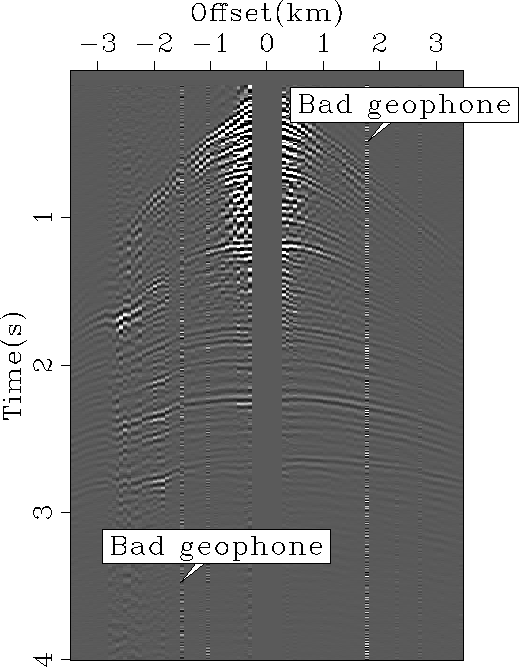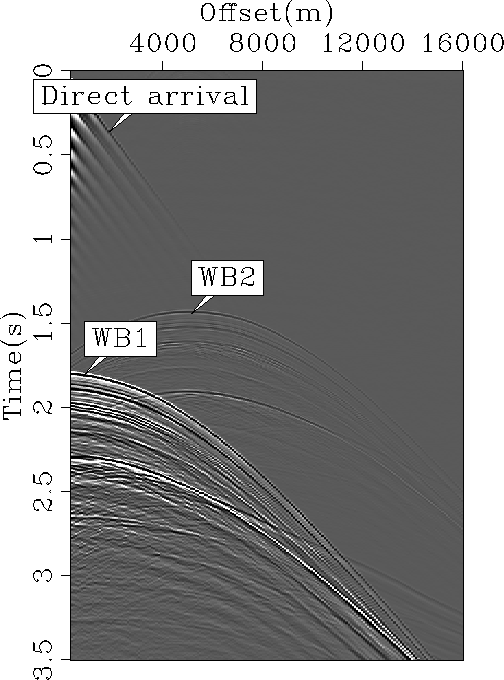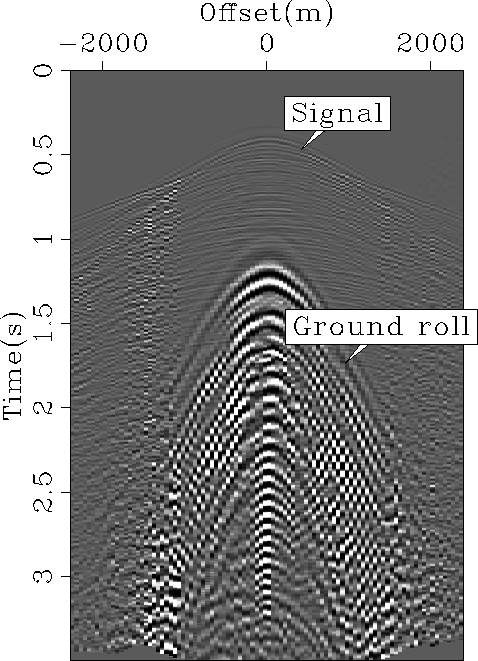|
wz.11
Figure 1 Land seismic record with few bad geophones. |  |
![[*]](http://sepwww.stanford.edu/latex2html/cross_ref_motif.gif) ) or
the recording systems can have glitches
) or
the recording systems can have glitches
|
wz.11
Figure 1 Land seismic record with few bad geophones. |  |
creating erratic noise in the seismic record. Wind motion or
cable vibrations can generate random noise.
Outside factors, such as mammal activity and/or drilling rigs
for marine acquisition might also contaminate seismic records.
These noise sources create more coherent energy on the data
and can be misinterpreted as true signal. As an illustration
Figure ![[*]](http://sepwww.stanford.edu/latex2html/cross_ref_motif.gif) displays a shot record from the Gulf of
Mexico with reflections generated from an unknown submarine location.
displays a shot record from the Gulf of
Mexico with reflections generated from an unknown submarine location.
|
gulf1
Figure 2 Marine seismic record with two water bottom reflections WB1 and WB2. WB1 is generated by the airgun towed by a seismic vessel. WB2 is created by a noisy source within the water column at offset 5000 m. The origin of this source is unknown. |  |
The second category of noise comes from modeling uncertainties
Tarantola (1987). In seismic, modeling uncertainties occur when the physical
description and parameterization of the earth is incomplete.
This incomplete description is motivated by the inherent complexity of
wavefield propagation in the subsurface. Therefore, the complex seismic signal
is often separated into different propagation modes that are then
easier to understand and use. The downside of this approach is that most
of the recorded signal is consequently obliterated. For instance with
land data, the ground roll (Figure ![[*]](http://sepwww.stanford.edu/latex2html/cross_ref_motif.gif) ), which might
), which might
|
dune
Figure 3 Shot record from a land acquisition in Saudi Arabia. The strong ground roll, although containing valid near-surface information, is often attenuated. The signal on the top needs to be isolated for further processing. |  |
contain useful near surface information, is attenuated
to unravel seismic reflections. Multiple reflections are a main source
of coherent energy in the seismic record that also need to be
separated from the primaries (i.e, reflections with one bounce in
the subsurface) before migration (Figure ![[*]](http://sepwww.stanford.edu/latex2html/cross_ref_motif.gif) ).
).
|
wz.30
Figure 4 Shot record from a marine acquisition in the Gulf of Mexico. The first reflections (WB) on the top, also known as primaries, are immediately followed by multiple reflections (WBM1, WBM2 and WBM3). An important step in seismic processing is to attenuate these multiples before migration to isolate the primaries. |  |
Whereas experimental errors rarely bring any useful information, recent advances in inversion and migration are slowly pushing the limits of modeling uncertainties by incorporating and saving as much signal as possible within the processing workflow. Among these techniques, full waveform inversion Sirgue and Pratt (2004); Tarantola (1986) bears promises by using all the subsurface reflections to derive an accurate earth model. Reverse time migration with the two-way wave equation Baysal et al. (1983); Youn and Zhou (2001) can theoretically migrate both multiples and primaries at the same time. One-way wave equation techniques can also migrate multiples but none-the-less require separation of primaries and multiples Berkhout and Verschuur (1994); Guitton (2002). Recently, Brown (2004) demonstrated how inversion can both image and separate multiples. Passive-seismic imaging Rickett and Claerbout (1999) can yield accurate depth maps by crosscorrelating noisy traces without any knowledge of the source location or spectrum.
Although very promising, most of these new techniques are still at an experimental level. Therefore, strategies for seismic noise attenuation are needed to preserve the signal of interest. In this thesis, spurious and coherent noise are attenuated using inverse theory. In particular, by analyzing the statistics of the noise, e.g., probability density functions (PDF) and patterns, we can decide what type of norm and what type of covariance operator are needed for the inversion. Covariance operators act as weighting functions of the data misfit (residual). They insure convergence of any inversion scheme toward independent and identically distributed (IID) residual components, a central assumption in least-squares inversion. In this thesis, covariance operators are approximated with multidimensional non-stationary prediction-error filters (PEFs).